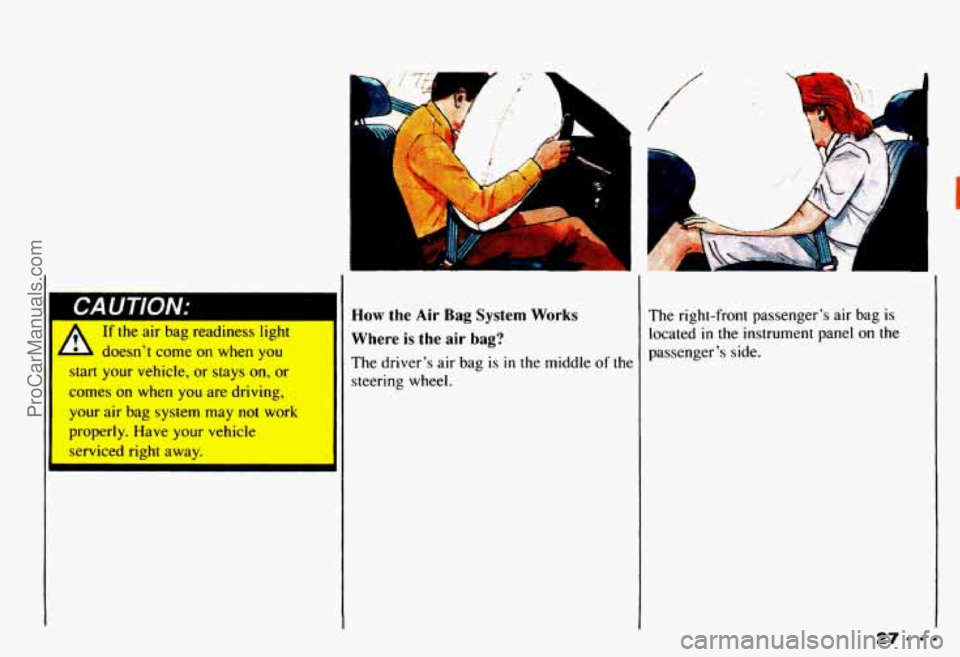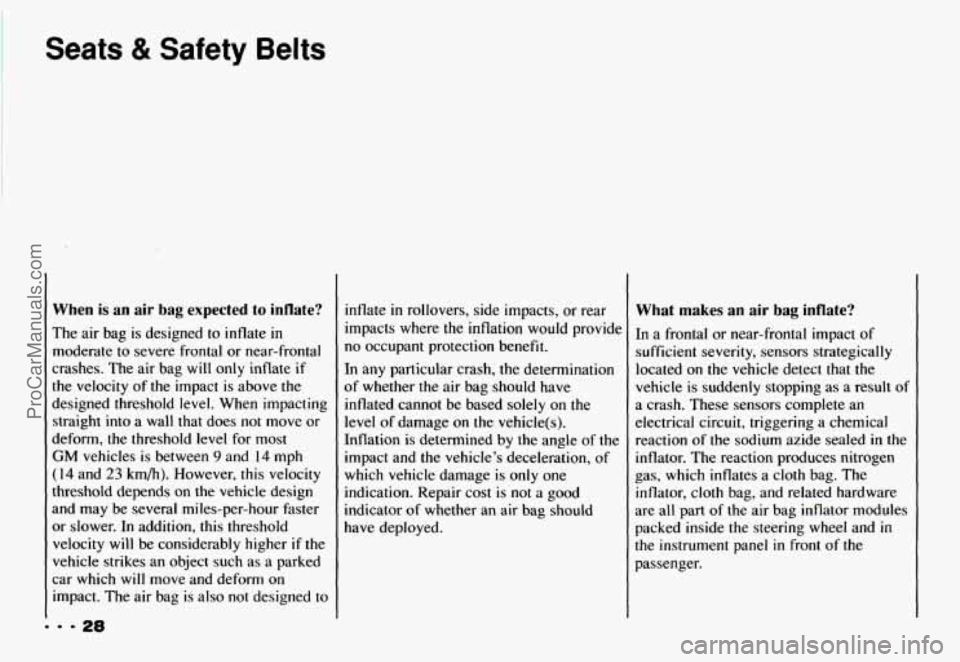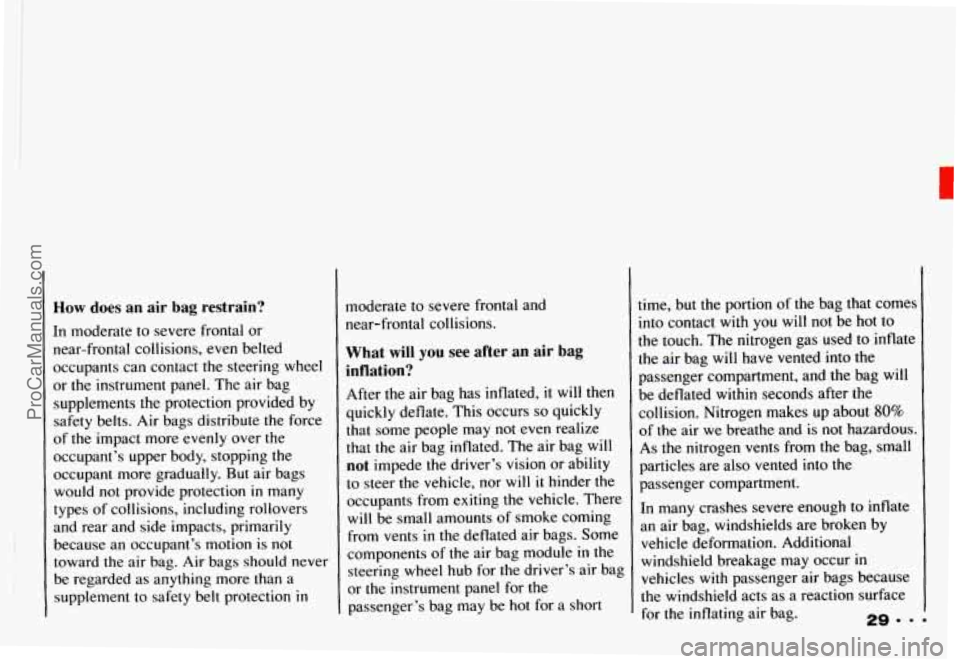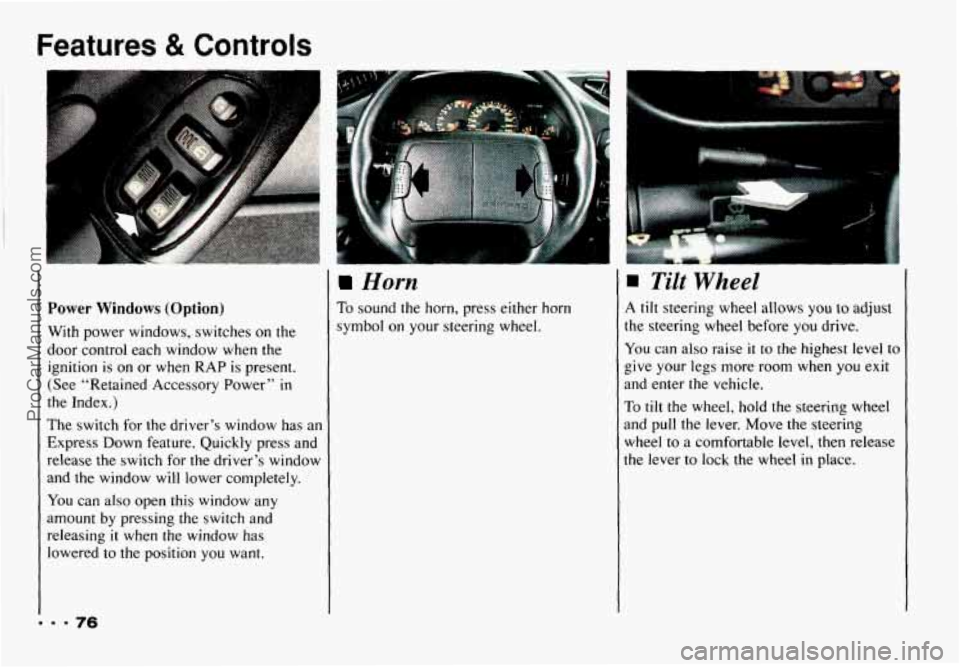1993 CHEVROLET CAMARO steering wheel
[x] Cancel search: steering wheelPage 31 of 358

If the air bag readiness light
d b doesn’t come on when you
start your vehicle, or stays on, or
comes on when you are driving,
your air bag system may not work
properly. Have your vehicle
serviced right away.
I
1
How the Air Rag System Works
Where is the air bag?
The driver’s air bag is
in the middle of the
steering wheel.
Y
p
The right-front passenger’s air bag is located
in the instrument panel on the
passenger’s side.
ProCarManuals.com
Page 32 of 358

Seats & Safety Belts
When is an air bag expected to inflate?
The air bag is designed to inflate in
moderate to severe frontal or near-frontal
crashes. The air bag will only inflate
if
the velocity of the impact is above the
designed threshold level. When impacting straight into a wall that does not move or
deform, the threshold level for most
GM vehicles is between 9 and 14 mph
(14 and 23 km/h). However, this velocity
threshold depends
on the vehicle design
and may be several miles-per-hour faster
or slower. In addition, this threshold
velocity
will be considerably higher if the
vehicle strikes an object such as a parked
car which will move and deform on
impact. The air bag
is also not designed to inflate
in rollovers, side impacts, or rear
impacts where the inflation would provide
no occupant protection benefit.
In any particular crash, the determination
of whether the air bag should have
inflated cannot be based solely on the
level of damage on the vehicle(s).
Inflation is determined by the angle of the
impact and the vehicle’s deceleration, of
which vehicle damage is only one
indication. Repair cost
is not a good
indicator of whether an air bag should
have deployed.
What makes an air bag inflate?
In a frontal or near-frontal impact of
sufficient severity, sensors strategical
located on the vehicle detect that the
vehicle is suddenly stopping as a result of
a crash. These sensors complete an
electrical circuit, triggering a chemical
reaction of the sodium azide sealed
in the
inflator. The reaction produces nitrogen
gas, which inflates a cloth bag. The
inflator, cloth bag, and related hardware
are all part
of the air bag inflator modules
packed inside the steering wheel and
in
the instrument panel in front of the
passenger.
ProCarManuals.com
Page 33 of 358

How does an air bag restrain?
[n moderate to severe frontal or
near-frontal collisions,
even belted
occupants can contact
the steering wheel
or the instrument panel. The air bag
supplements the protection provided by
safety belts. Air bags distribute the force
of the impact more evenly over the
occupant’s upper body, stopping the
occupant more gradually. But air bags
would not provide protection in many
types of collisions, including rollovers
and rear and side impacts, primarily
because an occupant’s motion
is not
toward
the air bag. Air bags should never
be regarded as anything more than a
supplement to safety belt protection
in
moderate to severe frontal and
near-frontal collisions.
What will you see after an air bag
inflation?
After the air bag has inflated, it will then
quickly deflate. This occurs
so quickly
that some people may not even realize
that the air bag inflated. The air bag will
not impede the driver’s vision or ability
to steer the vehicle, nor will
it hinder the
occupants from exiting the vehicle. There
will be small amounts of smoke coming
from vents
in the deflated air bags. Some
components of the air bag module
in the
steering wheel hub for the driver’s air bag
or the instrument panel for the
passenger’s bag may be hot for a short
t
1
t
t
I
1
4
1 1
r >
ime, but the portion of the bag that comes
nto contact with you will not be hot to
he touch. The nitrogen gas used to inflate _._ .~ ~
he air bag will have vented into the
Iassenger compartment, and the bag will
Je deflated within seconds after the
:ollision. Nitrogen makes
up about 80%
3f the air we breathe and is not hazardous.
As the nitrogen vents from the bag, small
particles are also vented into the
passenger compartment.
In many crashes severe enough to inflate
an air bag, windshields are broken by
vehicle deformation. Additional
windshield breakage may occur
in
vehicles with passenger air bags because
the windshield acts as a reaction surface
.~~ ~
for the inflating air bag. 29-9.
ProCarManuals.com
Page 34 of 358

Seats & Safety Belts
CAUTlON;
on’t attach anything to
~ :e steering wheel pad. It
0
0
0
-* 9 30
might injure thedriver if the
air bag inflates.
Don’t set anything on or attach
anything
to the instrument
panel.
It might injure the
passenger
if the air bag
inflates.
The air bags are designed
to
inflate only once. After they
inflate, you’ll need some new
parts for your air bag system.
If you don’t get them, the air
bag system won’t be there
to
help protect you in another
crash.
A new system will
include air bag modules and
possibly other parts.
Let only qualified technicians
work on you# air bag system.
Improper service can mean
that your air bag system
won’t
work properly. See your dealer
for service.
I
may not work properly. You may
have
to replace both the air bag a
%ak the air bag cover.
: instrument panel. Don’ pen or
Servicing Your Chevrolet with the Air
Bag System
Please tell or remind anyone who works
on your Chevrolet that it has the air bag
system. There are parts of the air bag
system
in several places around your
vehicle. You don’t want the system to
inflate while someone is working on your
vehicle. The air bag system does not need regular maintenance.
Your Chevrolet
dealer and the
1993 Camaro Service
Manual have information about the air
bag system, including repair
or disposal.
I A For up to 2 minutes after the
L ignition key is turned off and
the battery disconnected, an air bag
can still inflate during improper
service.
You can be injured if you
are close to an air bag when it
inflates. Be sure to follow the proper
service procedures.
ProCarManuals.com
Page 57 of 358

When you park your Chevrolet and open
the driver’s door, you’ll hear a tone
reminding you to remove your key from
the ignition and take
it with you. Always
do this. Your steering wheel
will be
locked, and
so will your ignition. If you
have an automatic transmission, taking
your key out also locks your transmission.
And remember to lock the doors.
Parking at Night: Park in a lighted spot,
close all windows and lock
your vehicle.
Remember
to keep your valuables out of
sight. Put them in a storage area, or take
them with you.
Parking Lots: If you park in a lot where
someone will be watching your vehicle,
it’s best to lock it up and take your keys.
But what if you have to leave your
ignition key? What
if you have to leave
something valuable
in your vehicle?
0 Put your valuables in a storage area,
like your glove box.
0 Lock the glove box.
0 Lock all the doors except the driver’s.
Then take the door key with you.
,I
Your vehicle is equipped with the
PASS-Key II@ (Personalized Automotive
Security System) theft-deterrent system.
PASS-Key II@ is
a passive theft-deterrent
system. This means you don’t have to do
anything different to arm or disarm the
system. It works when you insert or
remove the ke from the ignition.
PASS-Key I1 uses
a resistor pellet in
the ignition key that matches a decoder
in your vehicle.
When the PASS-Key
II@ system senses
that someone is using the wrong key,
it
shuts down the vehicle‘s starter and fuel
systems.
For about three minutes, the
starter won’t work and fuel won’t
go to
d
53-
ProCarManuals.com
Page 59 of 358

Off (C): Unlocks the steering wheel,
ignition and automatic transmission, but
does not send electrical power to any
accessories. Use this position
if your
vehicle must be pushed or towed.
A
warning tone will sound if you open the
driver’s door when the ignition is
in Off
and the key is in the ignition.
Run (D): Position to which the switch
returns after you start your engine and
release the switch. The switch stays
in the
Run position when the engine is running.
But even when the engine is not running,
you can use
Run to operate your
electrical power accessories and to
display some instrument panel warning
and indicator lights.
ProCarManuals.com
Page 61 of 358

I
rn
1
I
I
NOTICE:
I. If your key seems stuck in LOCK 1
and you can’t turn it, be sure it is all 5
the way in. If it is, then turn the
steering wheel left and right whil
you turn the key hard. But turn
tt
key only with your hand. Usir
tool
to force it could break the key
or
the ignition switch. If none of thi:
works,
then your vehicle nvAr
service.
T
i
ietained Accessory Power (RAP)
f you have power door locks, your
lehicle
has a feature called Retained
kcessory Power (RAP). With RAP your power
door locks, electric mirrors, power
windows, audio system and remote hatch
release will continue
to work up to 10
minutes after the ignition key is turned to
Off and neither door is opened.
If a door is opened, the audio system and
power windows will shut off. The power
door locks, electric mirrors and remote
hatch release will work
until you shut the
door. Once you have shut the
door, these
accessories
will continue to work for
approximately
35 seconds. After this
time you
will not be able to use these
accessories
until the next time you open
a
door or turn on the ignilion.
Starting Your Engine
Automatic Transmission: Move your
shift lever to P (Park) or N (Neutral).
Your engine won’t start
in any other
position
- that’s a safety feature. To
restart when you’re already moving,
use
N (Neutral) only.
NOTICE: I
Don‘t try to shilt to P (Park) if your
Chevrolet is moving.
If you do, vou
could damage the transmission,
Shift
to P (Park) o
V
ProCarManuals.com
Page 80 of 358

Features & Controls
Power Windows (Option)
With power windows, switches on the
door control each window when the
ignition is on or when
RAP is present.
(See “Retained Accessory Power”
in
the Index.)
The switch for the driver’s window has an
Express Down feature. Quickly press and
release
the switch for the driver’s window
and
the window will lower completely.
You can also open this window any
amount by pressing the switch
and
releasing it when the window has
lowered
to the position you want.
Horn
To sound the horn, press either horn
symbol on your steering wheel.
Tilt Wheel
A tilt steering wheel allows you to adjust
;he steering wheel before
you drive.
You can also raise it to the highest level to
give your legs more room when
you exit
md enter the vehicle.
To tilt the wheel, hold the steering wheel
md pull the lever. Move the steering
wheel to a comfortable level, then release
he lever
to lock the wheel in place.
... 76
ProCarManuals.com